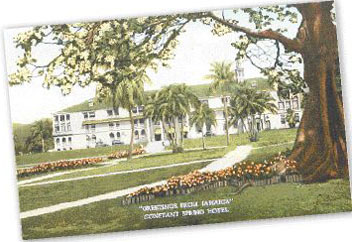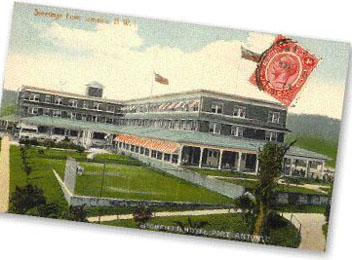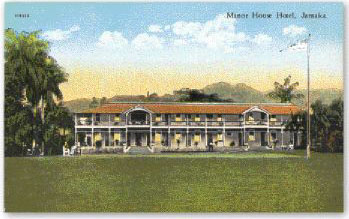What
are you thinking about, you Northern men and women, who rush to Florida,
or Bermuda, or Europe in search of a winter resort? Why, do you not
know of this lost Garden of Eden, this incomparable combination of American
comfort, English cleanliness and Italian Climate? And such beauty, such
glory of colouring, such opulence of Nature's best gifts! There are
no reptiles and there is fruit and vegetables enough to keep one well
and hearty at small cost with small labour. America cannot be long blind
to the wonderful advantages offered by this beautiful spot as a winter
resort...
SO
WROTE the much-travelled author, Ella Wheeler Wilcox in the early 1900s.
During this time, travellers to Jamaica came aboard United Fruit Company
steamers and also New Yorkers, particularly, on the Hamburg-American
Line West Indian cruises. A round trip from New York cost $75 and took
5-6 days.
Jamaica has provided
first class accommodation since the late 1800s. In 1890 the Jamaica
Hotels Law was passed to jumpstart the hotel industry. It authorized
the government to guarantee the principal plus 3% interest on all debentures
issued by hotel companies. This was done in great part to stimulate
the staging of Jamaica's Great Exhibition of 1891.
By the late 19th
century/early 20th century (prior to the 1907 earthquake) Kingston was
a thriving port town and visitors arrived on steamships by the thousands.
Banks, life and fire insurance companies, building societies and discount
associations flourished and electric lights began to take the place
of gas in principal buildings. Harbour Street, one of Kingston's main
business areas, became known for the Myrtle Bank Hotel, one of three
hotels constructed in Kingston and St. Andrew to accommodate visitors
to the Great Exhibition.
Rebecca
Tortello
Hotels
of the Great Exhibition
 |
|
Constant
Spring Hotel in Kingston
|
THE MYRTLE BANK
HOTEL
Built
in the mid-1800s, the Myrtle Bank, owned by Scotsman James Gall, was
converted from a shipyard into a select boarding house and offered personal
advice on health issues. By 1875 when downtown Christmas Bazaars became
popular and drew large crowds, the Myrtle Bank became a recreational
and social centre. A music stand was erected in the centre of its tropical
garden and The West India Regiment Band entertained large crowds twice
a week. When Gall died the property was acquired by the government and
a modern hotel with long French windows that opened on all sides into
verandahs, was built on the site in preparation for the Great Exhibition
of 1891. It was destroyed in the 1907 earthquake, reconstructed in 1918
and sold to the United Fruit Company. At that time it was the largest
hotel in Jamaica with 205 rooms and a filtered salt water pool.
THE CONSTANT SPRING
HOTEL
Also built
in preparation for the 1891 Exhibition when over 300,000 visitors were
expected on the island, this hotel was located at the end of an electric
tram car line about six miles from the city of Kingston. It is credited
with being the first building to have electricity and indoor plumbing.
The Constant Spring Post Office was set up to facilitate hotel guests.
By the mid-1890s it too had been taken over by the government. Situated
on 165 acres, the Constant Spring Hotel had 100 rooms and was known
as the Golfer's Hotel because of its 9-hole course which was extended
to 18-holes by the 1930s. It offered special dining and entertainment
options for children, lavish bedrooms, sitting rooms, dining rooms and
parlours, a French chef and hairdressing, as well as a gazebo and a
magnificent swimming bath. Yet the hotel rarely turned a profit and
in the 1940s it was sold to the Franciscan sisters who were looking
for a new home for their convent and school having lost their original
location on Duke St in 1937 to fire. In 1941 Immaculate Conception School
opened with 99 students and 16 boarders, mostly daughters of wealthy
Jamaican, Cuban, Haitian and Canadian Catholic families.
QUEEN'S HOTEL
The Queen's
Hotel, located at the corner of Heywood and Princess Streets in Kingston
was erected to house the working classes at the time of the Great Exhibition.
It was built by Colonel Ward, benefactor of the Ward Theatre, to supply
a want long felt by country folk, that, namely of obtaining in Kingston
comfortable quarters at reasonable process within their means. In the
years that followed Queen's was patronized mainly by market women who
needed overnight accommodation.
THE MONEAGUE
HOTEL
Not all of the hotels built for the Grand Exhibition of 1891 were located
in or near to Kingston. The Moneague Hotel, now the site of the Moneague
Teacher Training College, was built around 1890. In 1904 it advertised
itself as the most charming in the island, serving vegetables from its
gardens, water from its well, tennis, croquet and shooting. Visitors
travelled by train to Ewarton and were met by a hotel carriage for the
journey over Mt. Diablo. Within the next few decades when motor cars
became fashionable and train usage declined, the Hotel suffered as it
was no longer needed as a stopover.
Other
Great Hotels
 |
|
Titchfield
Hotel in Portland, Jamaica
|
THE TITCHFIELD
HOTEL
The growth of this hotel in Portland is directly linked to the banana
trade which expanded in the late 1800s to make Portland the second most
important town in Jamaica. By 1902 Capt. Lorenzo Dow Baker's Boston
Fruit Company (which later became the United Fruit Company) controlled
the island's entire banana trade and Baker began to use his steamships
to carry tourists as well as bananas. Baker built the Titchfield Hotel
in the early 1900s. In 1905 the hotel boasted 600 feet of piazza and
400 rooms. It was said that no hotel this side of the Atlantic is provided
with more of those conveniences that minister so largely to the pleasure
of travellers. The hotel and the parish suffered greatly with the decline
in the banana industry in the 1930s. One of its great claims to fame
is that it was once owned by famous Hollywood swashbuckler Errol Flynn
who died before he could put any of his plans to develop the hotel into
place. In the late 1960s the hotel was destroyed by fire. Today only
the ruins of this great landmark still stand.
THE RIO COBRE
HOTEL
The Rio Cobre Hotel, a small hotel in Spanish Town, was named after
the river running through the property. Two storeys and 27 rooms, it
had a high reputation for 'Creole' cooking and a 'couples rate' of 6
shillings per day.
OTHER SMALL HOTELS
 |
|
Manor
House Hotel, Jamaica
|
Another good example
is the Mandeville Hotel, set 2000 ft. above sea level in the cool Manchester
hills. In 1875, buildings formerly used as British officers' quarters
were converted into the Waverly Hotel.
By 1898 it was taken
over by Miss Jane Brooks, and the 17-room hotel became known as the
Brooks Hotel and then, as the Mandeville Hotel. In its early days the
Mandeville Hotel was famed for its distinguished patronage, cuisine,
and special events such as the Flower Show Dance.
In 1971 new buildings replaced the old structure. In the mid-1980s the
present owners, the McIntyres, took over the reins adding their own
personal touches such as the reintroduction of the hotel's traditional
fretwork.
Many small hotels, such as the Mona Hotel, were also converted from
Great Houses. Once the
residence of the owner of the Mona Sugar Estate on part of what is now
the University of the West Indies, the Mona Hotel provided open air
dining and offered trips to nearby Hope Botanical Gardens. Like the
Mona Hotel, Shaw Park, Eaton Hall, Tryall and Richmond Hill hotels were
also
former estate homes.



